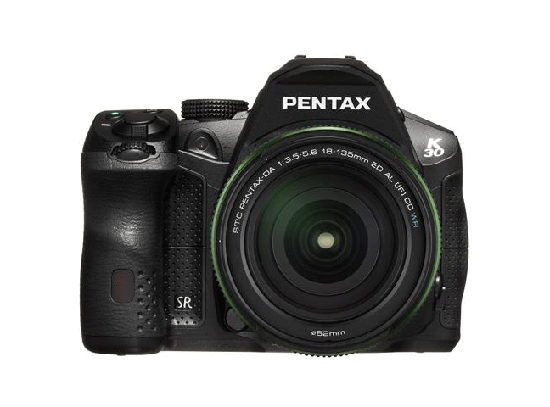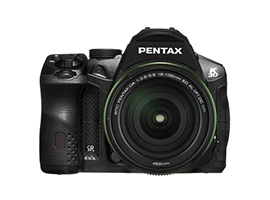Introduction

With a DxOMark Score of 79, the Pentax K-30 takes 23rd place among all cameras tested on DxOMark, tied with such older-generation full-format digital reflex cameras as as the Canon EOS 5D Mark II, the Sony Alpha 900, and the Sony Alpha 850.
The K-30 is only one point behind the Nikon D7000, D5100, and D700, and only two points behind the Canon EOS 5D Mark III. Such results are harbingers of image quality of the highest caliber, and corroborate our hypothesis that the K-30 is equipped with a Sony 16Mpix CMOS sensor.
The Pentax K-30 is very close to all of the benchmark cameras on the digital photo market: after all, when it comes to DxOMark Scores, a difference of 5 points represents only 1/3 of a stop. Be careful, however: the K-30’s excellent ranking is primarily due to its very good performance at low ISOs, and even then, its low-light performance is still a ways behind that of full-format cameras.
Color depth: At 23.7 bits, the Pentax K-30 places 23rd in the rankings, thus a score in perfect alignment with its overall score. Its result is 1.8 bit lower than those of the heavyweights (the Nikon D800 and D800E), but is nearly equivalent to the 24 bits of the Canon EOS 5D Mark III.
Dynamic range: Here we find the excellent behavior of the K-30’s 16-Mpix Sony APS-C CMOS sensor — a dynamic range score of 13EV that puts this amateur tropicalized camera at 18th place in the rankings. Its score is slightly lower than those of cameras presumably equipped with the same sensor, such as its big brother, the K-5 (which scored 14.1EV, putting it in 3rd place), but it comes out slightly ahead of the Sony NEX-5N.
Low-light ISO: The K-30’s score of 1129 ISO puts it in 23rd place yet again on our list — the same performance level as for color depth and for overall score.
Pros
- Excellent color depth
- Good sensitivity
Cons
- A dynamic range slightly inferior to that of the Pentax K-5
- Significant smoothing from 1600 ISO onwards that limits the resolution
Pentax K-30 vs K-5
The overall results obtained by the two Pentax digital reflexes are very close, with only 3 points’ difference in favor of the expert model K-5 — a lead of only 1/3EV. Although the color depth is absolutely identical for the two cameras and the low-light sensitivity is in the same general ballpark, we nonetheless note a real difference in dynamic range between the two cameras: only 13EV for the K-30 (the same as for the K-01, Pentax’s compact hybrid equipped with the same sensor) versus 14.1EV for the K-5 (the champion in this category). The K-5 has the advantage of an 80 ISO setting that lets it improve its dynamic range score, and gives it slightly better control of shadows than the K-30 (this said, a difference in dynamic range of only 0.7EV at 100 ISO will be difficult to detect in photos).

Pentax K-30 vs K-x
With a DxOMark Score of 79, the K-30 marks a tangible advance over the K-x, Pentax’s entry-level reflex, which scored a total of 72 points during its passage through the testing process. The difference translates into a qualitative gain of a little more than one third of a stop. The color depth of the new reflex is better than the entry-level model by about a bit, and the dynamic range is only a half-stop better because the K-30 doesn’t take full advantage of the dynamic range usually found for this sensor. But it’s the K-30’s low-light sensitivity that is its most important advantage over the entry-level K-x: more than 1/3 stop, 1129 ISO vs 811 ISO.
Pentax K-30 vs Nikon D3200
Even though the Nikon D3200 is not as tropicalized as the Pentax K-30, we know that the Nikon’s 24 Mpix CMOS sensor will be used in other cameras slated to appear in the coming months, just as it is already being used in the Sony NEX-7 and SLT-A77.
The overall image quality measured for the two cameras is very similar, giving only a very tenuous 2-point advantage to the 24-Mpix sensor, which benefits from a color depth score of 24.1 bits versus 23.7 bits for the 16-Mpix CMOS sensor. In terms of sensitivity, the score for both sensors is equivalent, even though when viewed on a screen, a photo taken at high sensitivity with the Pentax will be more flattering (this advantage disappears on an A4 print).
Note how the Pentax’s signal-to-noise ratio takes a jump at 1600 ISO and higher when compared to the D3200.

Pentax K-30 vs Canon EOS Rebel T3i / EOS 600D
DxOMark Score: With a DxOMark Score of 65 vs 79, the 18Mpix APS-C sensor of the Canon digital reflex shows a performance gap with respect to the Pentax. This gap is in evidence across all image quality performance criteria. Of particular note is how the gap widens for the “studio” scores in which we evaluate sensor quality at low ISO.
Color depth: 22.1 bits vs 23.7 bits in favor of the Pentax — and this difference is important when comparing two cameras of the same generation.
Dynamic range: 1.5EV separates the cameras in favor, once again, of the Pentax. We know that the Canon CMOS is not very generous when it comes to dynamic range — and in fact, it makes no progress in this regard after 400 ISO, in contrast to the behavior of the K-30, which itself is not the best in this category in the Pentax line.
Low-light sensitivity: The Pentax achieves a score that is ½ EV superior than the Canon. As one can very clearly see on the SNR curves measured at different sensitivities, the Pentax is relatively close to the Canon EOS 600D up to 1600 ISO. 1600 ISO happens to be the last sensitivity at which the two cameras evolve within the same world, because starting at 3200 ISO, the Pentax applies smoothing that softens the image and limits noise — but at the expense of sharpness.


In the Pentax K-30 we see the excellent image quality of its Sony CMOS sensor, particularly with respect to high sensitivity and a very fine color depth that matches that of many full-frame reflex cameras. As for dynamic range, however, we see a slight retreat when compared to the Pentax K-5, which has the advantage of an 80 ISO setting (and thus more generous exposure latitude). At higher sensitivities, the K-30 sensor performance differs from its competitors’ because of significant smoothing that limits noise but affects image sharpness.










DXOMARK encourages its readers to share comments on the articles. To read or post comments, Disqus cookies are required. Change your Cookies Preferences and read more about our Comment Policy.